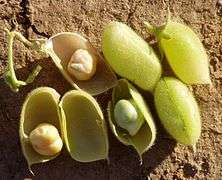Extremaduran cuisine
Extremadura, Spain is known for its different ways of preparing the Iberian pork and mutton. The main characteristics of the traditional Extremaduran cuisine were its simplicity, its lack of clutter and its low cost. It is also a cuisine reflecting a generous spirit, for many of its preparations used to be cooked in large pots to share with visitors, friends and neighbors. The resulting dishes are eaten with local bread.
The preferred spices in Extremaduran cuisine are pennyroyal, garlic, bay leaves and anise. Olive oil is used for frying and as an ingredient in many dishes.
Representative dishes

Among the pork or mutton-based dishes, some of the most well-known are the callos con manos de cerdo (tripe with pig's feet), caldereta de cordero (mutton stew), cabrito en cuchifrito, frite de cordero (mutton fry) and the cabrito a la hortelana (lamb stew with vegetables).[1]
The chanfaina in Extremadura has nothing to do with similarly named dishes in the Iberian Peninsula, like the Catalan Xanfaina, which is a Spanish version of the Occitan Ratatouille. The Extremaduran chanfaina is a rich stew of mutton liver, brain, heart and kidneys cooked with a mixture of bay leaves, garlic, bread crumbs and boiled eggs.
Traditional Extremaduran gastronomy includes other meats, like hen (gallina), which is one of the main ingredients of the emblematic cocido extremeño stew, hare arroz con liebre (rice with hare) and frogs ancas de ranas fritas (fried frog legs). It also includes local fishes like the tench tencas fritas (fried tenches) and trout truchas con jamón (trout with ham), and even a certain large lizard usually prepared in guisado, made by frying slices of lizard in olive oil, after which they were stewed over a slow fire.[2][3][4] Currently lizards are a protected species and trapping them is prohibited.[5]
Among the basic popular dishes the ones based on chick peas are dominant. Other main ingredients are habichuelas (beans), potatoes, pumpkin, chestnuts, onions and bell peppers. The most famous dishes of Extremadura are the cocido extremeño, the potaje de garbanzos y judías blancas (chick pea and bean soup), the sopa blanca de ajos (white garlic soup), the potaje de castañas secas (chestnut soup), the olla con "asaura" (a stew with offal and blood), the Ajoblanco extremeño and the gazpacho extremeño (a variant of gazpacho with ham).[6] There is very little in the way of vegetarian dishes in the traditional cuisine.
Some of the ancestral dishes of Extremadura are fast disappearing, like the migas and the gachas. These are very ancient dishes, one of the most prominent being the migas con torreznos.[7] Vegetables like cardoon and borage were formerly widely used in soups.
Certain dishes of the Extremaduran cuisine show the influence of neighboring Portugal, like the lentejas estofadas (stewed lentils) and the sopa de perdices (partridge soup).
Embutidos
Extremadura's Iberian pigs are usually left to roam in relative freedom and their main diet are the acorns falling from the local oak trees. Their meat is highly valued throughout Spain, especially their ham.
Extremaduran embutidos (pork preserves) have a local flavor, like the morcilla «Felisa» (based on blood and onion), morcillas de cabezá (head innards morcillas), morcillas patateras (potato morcillas), as well as morcillas prepared with pumpkin. Dry-cured pork products include chacinas and the local ham, longaniza and chorizo.
Desserts and sweets
Extremaduran desserts and sweets are mostly prepared using the local wheat flour, honey, pork fat, milk, sugar and olive oil. The most well-known are the buñuelos, magdalenas (anise-parfumed muffins), perrunillas, galletas, rosquillas de vino, roscas fritas (fried doughnuts), coquillos de miel, hijuelas, gachas extremeñas, bollos fritos (fried buns), floretas, socochones hurdanos and the jeringas. [8]
References
- ↑ Gastronomia de las Hurdes
- ↑ Lorenzo Díaz, (2001), Los sabores perdidos, Ed. Edaf. pag. 178 Gastronomia extremeña
- ↑ Gastronomía tradicional extremeña
- ↑ Los hábitos culinarios en el pasado extremeño
- ↑ Gastronomía extremeña
- ↑ Ajo Blanco Extremeño
- ↑ Saber Popular - Revista extremeña de folklore
- ↑ Gastronomia de Extremadura, Revista Alcántara. nº 56
External links
- Extremadura Tourist Board Official Webpage in english
- Cocina y gastronomia de Extremadura. Platos Típicos Extremeños (Spanish)